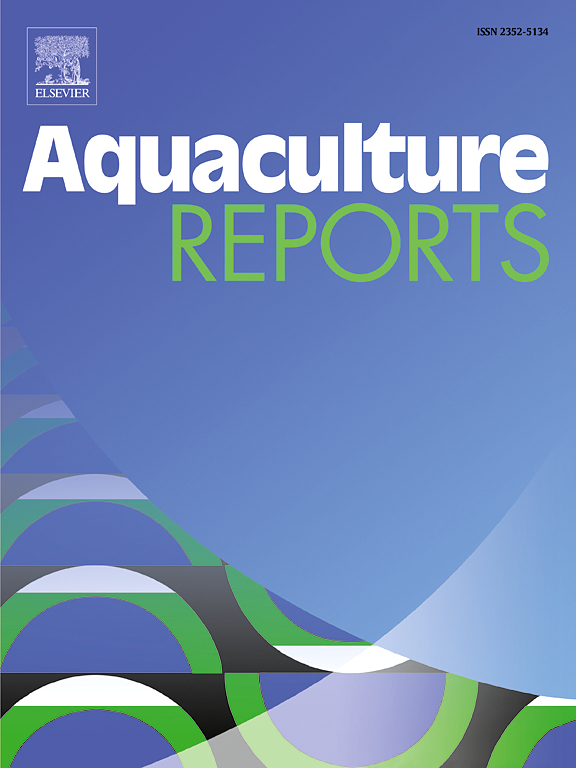High inclusion of corn gluten meal supplemented with butyric acid; Impacts on growth, immunology, histopathology, and metabolomics of pacific shrimp
IF 3.2
2区 农林科学
Q1 FISHERIES
引用次数: 0
Abstract
This research aimed to examine the impacts of adding butyric acid (BA) at elevated levels to corn gluten meal (CGM) in the Pacific shrimp diet. This study analyzed how adding BA to the diet impacts shrimp growth performance, immunology, metabolomics, and histopathological responses. A total of 720 shrimp were divided into six groups, each receiving a different level of BA supplementation: 0 %, 0.5 %, 1 %, 1.5 %, 2 %, and 2.5 %. The experiment spanned 56 days, with three replicates for each group. The initial mean weight of the shrimp was 0.18 ± 0.00 g. The results of the study indicated that final weight (FW), weight gain rate (WGR), and specific growth rate (SGR) all showed significant increases with increased levels of dietary BA (P < 0.05). The survival rate (SR) was 100 % across all treatment groups. Additionally, dietary BA led to a significant decrease in feed conversion ratio (FCR), with the most pronounced effect observed in the 1.5 % BA group (P < 0.05). The addition of BA to the diet resulted in a significant increase in the activities of alkaline phosphatase (AKP) and acid phosphatase (ACP). At the same time, the levels of aspartate and alanine aminotransferase decreased significantly (P < 0.05). Interestingly, malondialdehyde (MDA) levels decreased with higher BA supplementation, but superoxide dismutase (SOD) activity increased in shrimp-fed BA diets. Histological analysis of the hepatopancreas showed that shrimp-fed diets containing 1 % and 1.5 % BA had significantly higher B and R-cell numbers than the control group. Metabolomics analysis revealed that fatty acids such as palmitic acid, docosahexaenoic acid (DHA), stearic acid, and arachidonic acid were up-regulated in BA diets. The slope broken-line regression analysis of WGR against dietary BA levels suggested that the optimal BA requirement for L. vannamei shrimp was estimated to be 1.25 %.
添加丁酸的玉米蛋白粉含量高;对太平洋对虾生长、免疫学、组织病理学和代谢组学的影响
本研究旨在探讨在太平洋对虾饲料中玉米蛋白粉中添加一定量丁酸(BA)的影响。本研究分析了饲料中添加BA对对虾生长性能、免疫学、代谢组学和组织病理学反应的影响。将720只对虾分为6组,每组添加不同水平的BA: 0 %、0.5 %、1 %、1.5 %、2 %和2.5 %。试验期56 d,每组3个重复。初始平均体重为0.18 ± 0.00 g。结果表明,随着饲粮BA水平的升高,末重(FW)、增重率(WGR)和特定生长率(SGR)均显著升高(P <; 0.05)。所有治疗组的生存率(SR)为100 %。此外,饲粮中添加BA显著降低了饲料系数(FCR),其中以添加1.5 % BA组效果最为显著(P <; 0.05)。饲粮中添加BA显著提高了碱性磷酸酶(AKP)和酸性磷酸酶(ACP)活性。同时,天冬氨酸和丙氨酸转氨酶水平显著降低(P <; 0.05)。有趣的是,随着BA添加量的增加,丙二醛(MDA)水平降低,但超氧化物歧化酶(SOD)活性增加。肝胰腺组织学分析表明,饲料中BA含量为1 %和1.5 %的对虾的B细胞和r细胞数量显著高于对照组。代谢组学分析显示,脂肪酸如棕榈酸、二十二碳六烯酸(DHA)、硬脂酸和花生四烯酸在BA饲料中上调。对增重率与饲料中BA水平的斜率折线回归分析表明,凡纳滨对虾的最佳BA需取量为1.25 %。
本文章由计算机程序翻译,如有差异,请以英文原文为准。
求助全文
约1分钟内获得全文
求助全文
来源期刊

Aquaculture Reports
Agricultural and Biological Sciences-Animal Science and Zoology
CiteScore
5.90
自引率
8.10%
发文量
469
审稿时长
77 days
期刊介绍:
Aquaculture Reports will publish original research papers and reviews documenting outstanding science with a regional context and focus, answering the need for high quality information on novel species, systems and regions in emerging areas of aquaculture research and development, such as integrated multi-trophic aquaculture, urban aquaculture, ornamental, unfed aquaculture, offshore aquaculture and others. Papers having industry research as priority and encompassing product development research or current industry practice are encouraged.
 求助内容:
求助内容: 应助结果提醒方式:
应助结果提醒方式:


